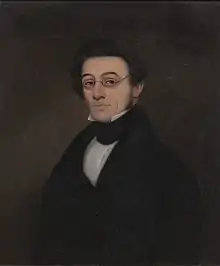John Solomon Cartwright
John Solomon Cartwright, QC (September 17, 1804 – January 15, 1845) was a businessman, lawyer, judge, farmer and political figure in Upper Canada. He was a supporter of the Tory political group.
John Solomon Cartwright | |
|---|---|
 | |
| Member of the Legislative Assembly of Upper Canada for Lennox and Addington County | |
| In office 1836–1841 | |
| Succeeded by | Position abolished |
| Member of the Legislative Assembly of the Province of Canada | |
| In office 1841–1844 | |
| Personal details | |
| Born | September 17, 1804 Kingston, Upper Canada |
| Died | January 15, 1845 (aged 40) Kingston, Canada West |
| Political party | Tory |
| Occupation | Lawyer, landowner, businessman |
Early life and family
Cartwright was born in Kingston, Upper Canada in 1804, the son of Richard Cartwright, a Loyalist, who died while John was around ten years old, and Magdalen Secord, sister-in-law of Laura Secord. His father had been a wealthy man, leaving him an inheritance of £10,000.[1]
In 1831, he married Sarah Hayter Macaulay, daughter of James Macaulay, by whom he left a family of seven children. His sister-in-law was Harriet Dobbs Cartwright and he was the uncle of Sir Richard John Cartwright, who also had a notable political career, although as a Liberal.
Legal and business career
After studying law at York and Oxford University he articled in the offices of John Beverley Robinson, a leader of the Tories and the Family Compact. He was called to the bar in 1825. In 1827, after the death of his mother, he continued to study law at Lincoln's Inn in London; he returned to Kingston in 1830.
In 1832, he became the first president of the Commercial Bank of the Midland District, the unanimous choice of the bank directors. In 1834, he became a judge in the Midland District and he was named Queen's Counsel in 1838.
Political career
In 1836, he was elected to the 13th Parliament of Upper Canada representing Lennox and Addington and represented it again in the 1st Parliament of the Province of Canada. He attempted to ensure that British institutions would be preserved in the new union. In 1843, he proposed a form of juvenile reform school that he called "Juvenile Houses of Refuge"; this resolution was not implemented. In 1844, he travelled to England to attempt to prevent the movement of the capital from Kingston to Montreal, Lower Canada.[1]
Rebellions of 1837–1838
Cartwight was a staunch supporter of the British colonial government during the Rebellions of 1837–1838, serving as lieutenant-colonel of the 2nd Lennox militia. As an officer, he sat on the court-martial which tried Nils von Schoultz, who had led the invaders from the United States at the Battle of the Windmill, in the Patriot War. The court-martial convicted Schoultz and condemned him to hang. Schoultz's defence counsel was a young lawyer from Kingston, John A. Macdonald.[1]
Philanthropist and patron of architecture
Cartwright is credited in having a major effect on the architecture of public buildings in Kingston by choosing or helping influence the selection of architects. Also, in Napanee, it is said that every public building including schools and churches was built on land donated by Cartwright.[1]
Death
Up until 1843, his estate of 881 acres (357 ha), Rockwood Villa, near Kingston, included a large farm with high quality livestock; he sold off some of his property as building lots at that time.
In 1845, he died at his home of tuberculosis.[1]
External links
- Cartwright family fonds, Archives of Ontario